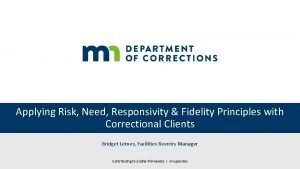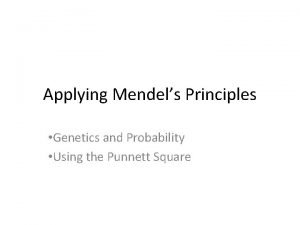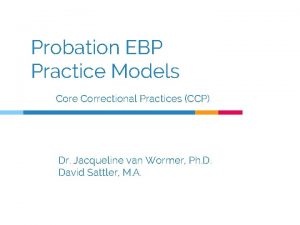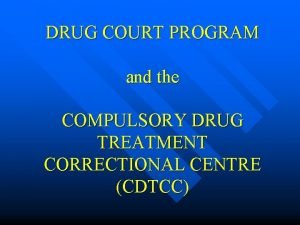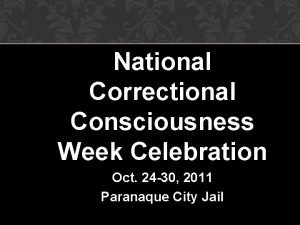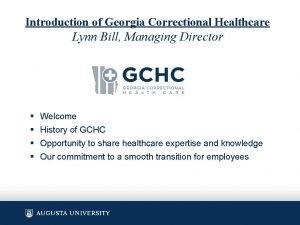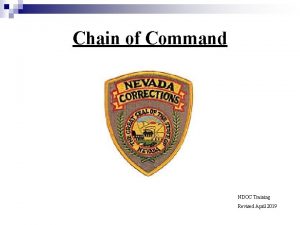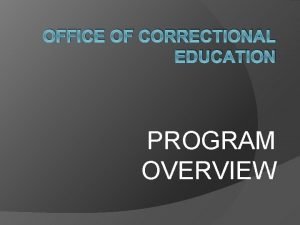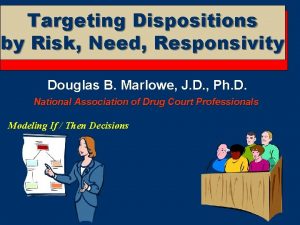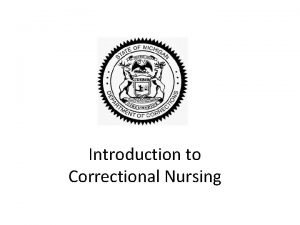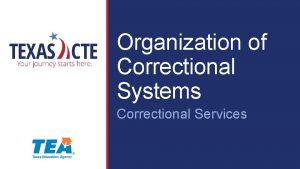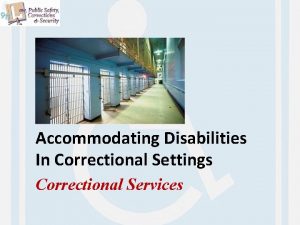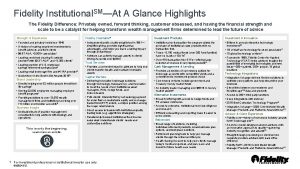Applying Risk Need Responsivity Fidelity Principles with Correctional























- Slides: 23

Applying Risk, Need, Responsivity & Fidelity Principles with Correctional Clients Bridget Letnes, Facilities Reentry Manager Contributing to a Safer Minnesota | mn. gov/doc

Contributing to a Safer Minnesota Reduce recidivism by promoting offender change through proven strategies during safe and secure incarceration and effective community supervision

Review of the Principles of Effective Intervention RISK NEED • Deliver more intense interventions to higher risk participants • Use CB • Target approaches criminogenic • Match needs to mode/style of reduce risk for service to recidivism participant • WHO • WHAT RESPONSIVITY FIDELITY • HOW WELL • Deliver services as designed

Why The Principles of Effective Intervention? • Put Research into Practice • Organize Our Resources • Understand Dosage • Focus on the Individual • Reduce Risky Thinking and Behaviors Contributing to a Safer Minnesota | mn. gov/doc

The Risk Principle Risk tells us “who” to target • Determine risk level through validated risk tool • Most tools categorize offenders into low, moderate, or high risk for reoffending • Match risk level to appropriate interventions and supervision level • Remember: it’s the risk of reoffending not the severity of the crime

The Need Principle Need tells us “what” to target • Interventions and programs should target criminogenic factors • Criminogenic factors are those highly correlated with recidivism • Criminogenic factors are dynamic or changeable

The Responsivity Principle Responsivity tells us “how” to change behavior • Specific Responsivity The participant’s attributes that limit and/or facilitate the participant’s learning style Address the barriers to change • General Responsivity Deliver content in a way that most people learn Do what works to promote change

The Responsivity Principle: Specific Responsivity External: Internal: Transportation Gender Childcare Motivation Housing/ Location Learning Style Fees Culture Mental Health

Specific Responsivity Assessments • TABE Testing- Literacy/Academics • SPDAT- Housing/Homelessness • Jesness Inventory- psychological/personality • PHQ 9 - Depression • Kessler 6 - depression and anxiety distress • PCL(C)- PTSD • TCU CJ Client Evaluation of Self and Treatment (CJ CEST) https: //ibr. tcu. edu/forms/tcu-core-forms/ Contributing to a Safer Minnesota | mn. gov/doc

General Responsivity • Structured social learning where new skills and behaviors are modeled • Cognitive behavioral approaches that target criminogenic risk factor

In te rn a l Ex te rn al Cognitive Model Actions Thoughts Feelings Attitudes/Beliefs Thinking for a Change v 3. 1

Benefits of Cognitive Behavioral Model • • • Action oriented Present-focused Based on theories of learning Step-wise progression Brief Scientific

Using Behavioral Practices 0. 35 0. 29 0. 25 0. 2 0. 15 0. 1 Reduced Recidivism 0. 3 0. 07 0. 05 0 Nonbehavioral (N=83) Behavioral (N=41) Andrews, D. A. (1994). An Overview of Treatment Effectiveness. Research and Clinical Principles, Department of Psychology, Carleton University. The N refers to the number of studies.

Why is CBT popular in corrections? • Can be done in any setting • Existing staff can be trained on CBT • Relatively cheap to deliver • Wide range of curriculums are available

Table and Large Group Discussion • What are a few things you do to address responsivity at your workplace? Is it Specific of General responsivity? Contributing to a Safer Minnesota | mn. gov/doc

The Fidelity Principle • Fidelity tells us “how well” programs incorporate risk, need, and responsivity. • Fidelity measures how closely programs align to the program design. • Fidelity can be measured and monitored during group facilitation, individual interactions, and in case planning.

The Fidelity Principle Make sure the program is delivered effectively! • Staff • Qualified, well trained and supervised, modeling appropriate behavior • Programs • Monitor delivery of interventions and programs • Participants • Address barriers, but target criminogenic needs • Provide appropriate dosage of treatment • Reassess offenders in meeting target behaviors


Program Integrity and Treatment Effect in Community Programs As Scores for Integrity Rise Program Lowers Recidivism 0 -19% 20 -39% 40 -59% 60+%

Program Integrity and Treatment Effect in Residential Programs As Scores for Integrity Rise Program Lowers Recidivism 0 -30% 31 -59% 60 -69% 70+%

What do we know about fidelity? • Fidelity is related to successful outcomes (i. e. , recidivism reductions) • Poor fidelity can lead to no improvement or even negative effects • Fidelity cannot be assumed • Fidelity can be measured and monitored

What’s Next? • Make some changes at your workplace to align with RNRF • Embed Cognitive Behavioral Interventions and programs at your workplace • Thinking Reports • Behavioral Chains • Cognitive Restructuring • More Training, Coaching, and Practice! Contributing to a Safer Minnesota | mn. gov/doc

Thank you! Bridget Letnes bridget. letnes@state. mn. us 651 -361 -7241 Contributing to a Safer Minnesota | mn. gov/doc
 What is the risk need responsivity model
What is the risk need responsivity model Risk needs responsivity
Risk needs responsivity Credit risk market risk operational risk
Credit risk market risk operational risk Chapter 12 lesson 2 applying mendels principles
Chapter 12 lesson 2 applying mendels principles Chapter 12 lesson 2 applying mendels principles
Chapter 12 lesson 2 applying mendels principles Chapter 12 lesson 2 applying mendels principles
Chapter 12 lesson 2 applying mendels principles Fiberglass cast disadvantages
Fiberglass cast disadvantages Chapter 12 lesson 2 applying mendels principles
Chapter 12 lesson 2 applying mendels principles Phenotype and genotype
Phenotype and genotype Applying mendels principles
Applying mendels principles Correctional nursing
Correctional nursing Core correctional practices
Core correctional practices What is corrections
What is corrections Collins correctional facility address
Collins correctional facility address Compulsory drug treatment correctional centre
Compulsory drug treatment correctional centre University college of norwegian correctional service
University college of norwegian correctional service 3rd degree felony
3rd degree felony Department of correctional services strategic plan
Department of correctional services strategic plan Nacocow celebration
Nacocow celebration Susan norton augusta university
Susan norton augusta university Correctional officer rank structure
Correctional officer rank structure Sexual harassment cases in correctional centres
Sexual harassment cases in correctional centres Office of correctional education
Office of correctional education Correctional funnel
Correctional funnel

